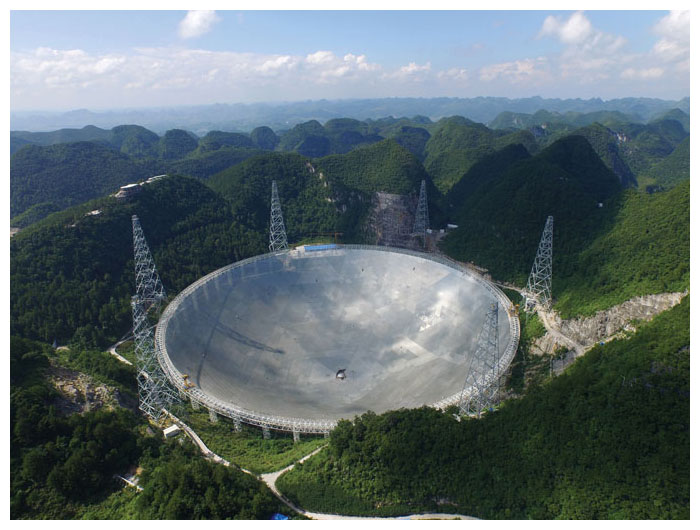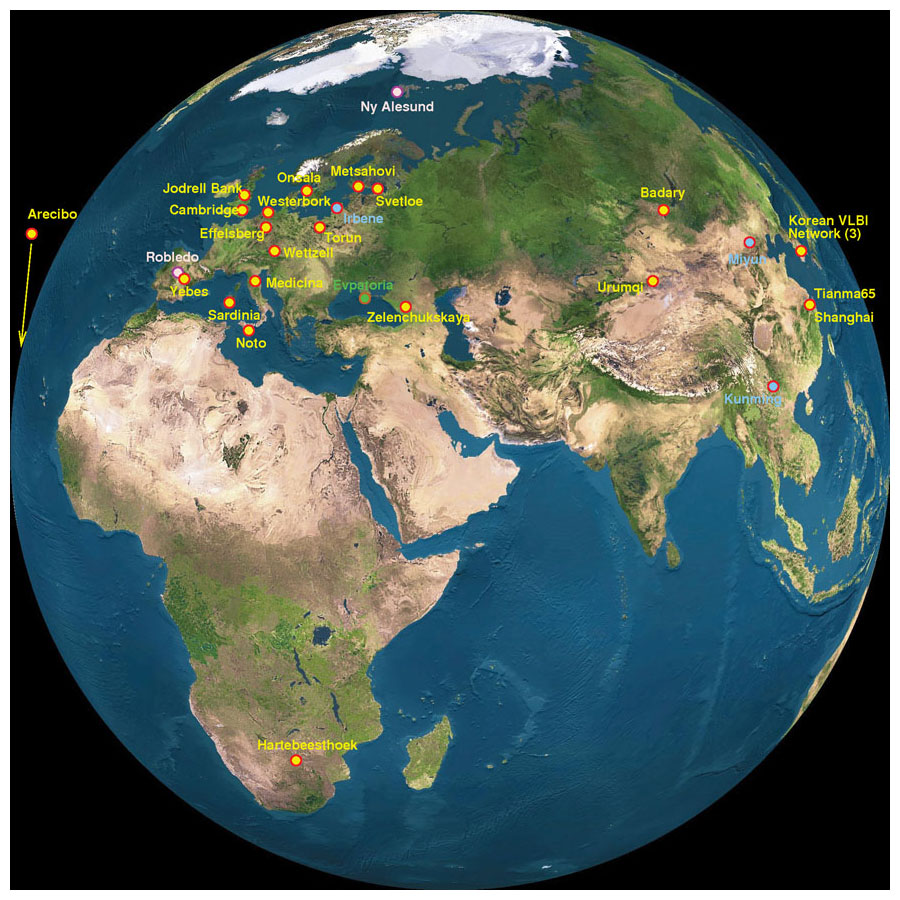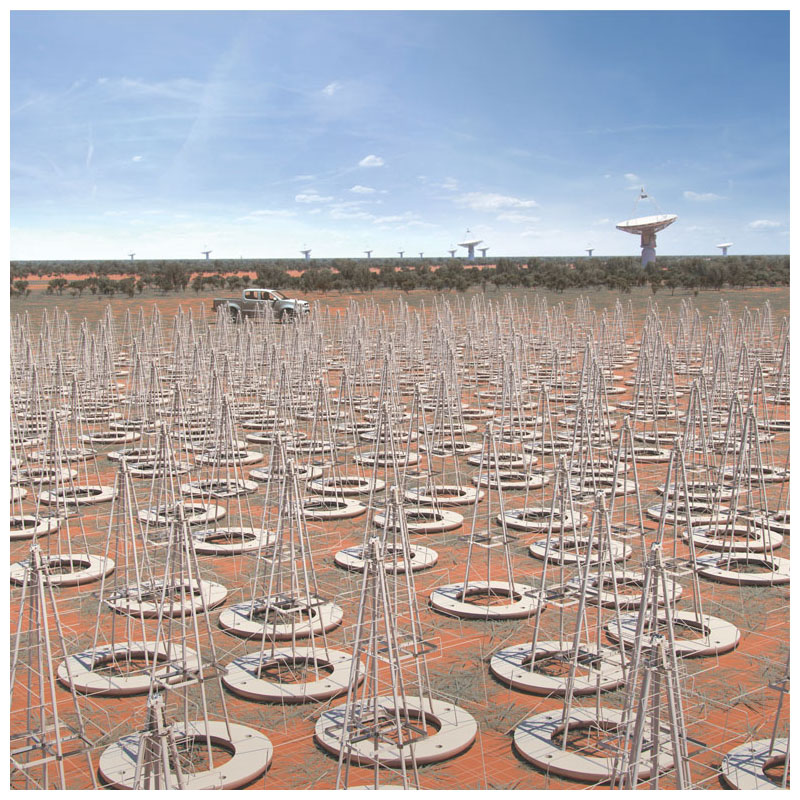Radio from the Sky
By Francis Graham-Smith
New, large telescope dishes and widespread arrays of receivers continue to provide insights into the nature of the universe.
New, large telescope dishes and widespread arrays of receivers continue to provide insights into the nature of the universe.

DOI: 10.1511/2016.123.362
The strangest thing about the universe is our ability to describe it, located as we are in the thin skin of an insignificant-sized planet inside a bewilderingly huge cosmos.
Although its extent in time and space is so far from our own local experience, we can describe with some precision how the universe developed from a dense fireball, expanded, and continues to expand on a measurable timescale. In contrast, we know much less about the smaller details: how exactly the stars and galaxies formed, and how we, the observers, are related to the complexities of the more local universe.

A century ago the known universe stretched only as far as our Milky Way galaxy. Nothing further was known to exist. The nature of our galaxy as merely one of an immense number of similar galaxies was a matter for speculation only. But to astronomers, the peak of emission from most stars lay in the visible spectrum, and there seemed little to be gained by exploring longer or shorter wavelengths. There are now entire subjects within astronomy that depend on observations made across the whole electromagnetic spectrum. Apart from minor extensions into ultraviolet and the near-infrared, radio was the first new window to be opened. The atmosphere is no barrier to radio waves, even when it is cloudy. But the wavelengths of radio are millions of times greater than those of light. New detector systems were essential.
Cosmic radio waves are like white light, covering a wide range of wavelengths. These radio waves that tell us so much about the cosmos are generated by energetic particles, usually electrons. The radiating electrons are often in a cloud of hot gas, as for example in the solar corona, and the intensity of their radio emission can then be used as a measurement of the temperature of the gas. The very energetic electrons of the cosmic rays that pervade our Milky Way galaxy also radiate radio waves, as discovered by Karl Jansky at Bell Telephone Laboratories in New Jersey in 1933. These similarly radiate with an intensity that depends on their individual energies.
In both these sources the radiation is spread over a wide spectrum. There are, however, cosmic radio sources whose radiation is concentrated in a narrow band of frequencies, as in the more familiar spectral lines of optical astronomy, or the sodium light from a street lamp. The light from a star contains spectral lines that are a rich source of information about the star and about its atmosphere, each spectral line being related to its own species of atom or molecule. Similarly, radio spectral lines are related to molecular species, and to one atomic species in particular: hydrogen. The intensity of a radio spectral line is related to both the abundance and the temperature of its related species, which might be a cold cloud of neutral hydrogen or molecules in a nebula energized by a hot star. There are spectral lines from hydrogen, and from helium and carbon, which originate in a step in energy of an electron orbiting around the atomic nucleus. The electron may originally be completely detached, falling in toward the nucleus in a series of steps, and for this reason the process is known as recombination radiation. Atomic hydrogen also has a very special and dominant spectral line due to an interaction between the nucleus and its single electron, known as spin coupling.
Another spectral line is observed at the low-frequency end of the radio spectrum from the hydroxyl molecule (or more properly, radical), written as OH–, like water with one hydrogen atom missing. This occurs in gas clouds, such as the bright visible cloud in Orion’s belt. At higher radio frequencies— that is, at shorter wavelengths—many familiar molecules, including oxygen, carbon monoxide, water, and ammonia, have been observed, each with many spectral lines. These can be observed in gas clouds throughout the Milky Way, and are found to be useful for determining the structure and dynamics of our galaxy.
Radio astronomy developed rapidly after World War II. Some of the most talented scientists in the United Kingdom and Australia had been drafted into radar development in 1939, and had spent six intense years inventing and exploiting new techniques for radio receivers and antennas. Immediately after the war, three major radio observatories were established, two in England and another in Australia.
There have been a number of large, steerable radio telescopes built worldwide since then, which have made outstanding observations. But the latest, and largest, is the Five-hundred-meter Aperture Spherical Telescope (FAST) in Guizhou Province, in southwest China. The telescope fills a deep depression in an extensive karst limestone formation, fortunately situated in a sparsely populated area in which radio and other electrical interference is minimal.
Correcting spherical aberration will be achieved at the surface, which is flexible. The area in use will be distorted into a paraboloid, removing the aberration and providing a simple focal point. This requires the surface to be adjusted by no more than 1 meter, but of course it must be continually adjusted as the telescope beam is moved across the sky. The surface is therefore constructed from 4,450 triangular aluminum panels, curved to conform with the spherical bowl and connected with flexible joints and a network of steel cables. At 2,225 points the supporting network is pulled from behind by cables attached to the ground through winches. Moving the beam then requires a continuous adjustment of 2,225 electric motors behind the dish, as well as the sideways movement of the feed with the receiver systems.
The overall accuracy of the telescope, including this active surface and the positioning of the feed system, will be within 5 millimeters, allowing the beam to be pointed to an accuracy of 4 arcseconds. The receiver systems of FAST are in a feed cabin suspended 140 meters above the surface and moveable sideways by up to 110 meters to swing the beam by 40 degrees from the zenith. The cabin is suspended by cables from six 100-meter high towers around the periphery of the dish, with winches to move the cabin over 110 meters along a circular arc. The cables will adjust the position to around 10 centimeters, and a fine movement system will then adjust the tilt angle and the position to 5 millimeters. This is altogether a most remarkable assembly of mechanical engineering.
FAST will operate initially at frequencies between 300 and 3,000 megahertz. Modem receiver techniques allow observations simultaneously over a wide frequency band and also with multiple beams. The initial instrumentation is for a wide bandwidth centered on the 21-centimeter hydrogen line, using 19 beams, each with two polarizations, feeding a total of 38 cooled low-noise receivers. This system will allow a dramatic extension of several branches of astronomy, mainly in what may be termed the Gaseous Universe. In our Milky Way galaxy, this means concentrating on the structure of the interstellar medium, including the gas clouds that extend far above and below the plane of the galaxy. The frequency range will include spectral lines from hydrogen, hydroxyl, and formaldehyde. Galaxies in the Local Universe will be accessible up to a moderate redshift, with possible new studies of their populations of pulsars and the dynamics of the gas clouds.
It takes only a brief look at the sheer size and complexity of the 500-meter FAST to realize that there will probably never be another such dish built anywhere in the world. This does not, however, mean that the continued increase in size and sensitivity of radio telescopes is coming to a halt. A new generation of telescopes with even larger apertures is already becoming available. These are all based on aperture synthesis, a concept that derives from radio interferometers.

It probably never occurred to Galileo that a telescope might one day make an image of a star as a disc rather than a point of light blurred by diffraction and scintillation. Better resolution can be achieved only with larger apertures, since the limit is simply determined by the ratio of the diameter of the aperture to the wavelength of light. In 1920, Albert Michelson showed how this limit could be overcome by extending the aperture, combining light from two separate mirrors to make a single image. This was the beginning of a new era in telescope design. As it happened, the principle was realized in radio astronomy more than in optical astronomy, eventually giving us the extensive arrays of radio telescopes that now dominate the scene, leading up to the huge international Square Kilometer Array. A telescope that combines light or radio waves from two apertures to make a single image is called an interferometer, and the multielement radio arrays that effectively build up a large single aperture are called synthesis arrays.
The practical problem was to construct a full image from all the interferometer outputs—a process requiring a computer with a capacity that did not exist until electronic computers became available. The role of the digital computer in allowing aperture synthesis to develop is analogous to the role of detector arrays in allowing optical telescopes to map huge areas of sky in a single observation. The development of computers was so fast that the new telescopes could be designed on the assumption that sufficient computing capacity would be available by the time construction of the telescope was complete. (This still happens today. The Square Kilometer Array is so demanding of computer capacity that the design is dependent on computers that have yet to be designed and built.)
Radio astronomers showed that useful maps could be made using only a small number of antennas, widely dispersed. The key was to use Earth’s rotation, observing for long periods as the planet spun so as to cover long arcs rather than tiny patches in the synthetic aperture. The essential requirement was that all pairs should be interconnected with stable links, either directly or using wide-bandwidth recorders. In the first such long-baseline array, which comprised six dish antennas spread over distances of up to 217 kilometers, the links were made by radio—hence the name, Multi-Element Radio-Linked Interferometer Network (MERLIN). This array, which is still in operation, is based at Jodrell Bank. It is spread over a large part of central England, where most of the tens of millions of inhabitants are unaware that they live within the aperture of one of the world’s largest radio telescopes. Aperture synthesis on such a large scale proved to be so useful that several long-baseline arrays were established on a continental and eventually an intercontinental scale. The demands for accuracy of the connections and of the analysis have increased as wavelengths have decreased, and as the radio receivers at the individual telescopes have improved. There is no limit to the possibilities of such interconnections, which can extend to any combination of telescopes on a worldwide scale.
The Square Kilometer Array is so demanding of computer capacity that the design is dependent on computers that have yet to be built.
The extreme example of this synthesis technique is the Square Kilometer Array (SKA), a huge radio telescope that is now being developed, and parts of which are already being brought into use as SKA Pathfinders. The name of the SKA refers to the total collecting area of the many thousands of telescope elements, which will be spread over a much larger area. SKA will operate with hundreds of beams simultaneously, and on multiple frequencies. The number of simultaneous observations will be limited only by the processing capacity of the central computers, whose exacting specification is based on developments expected during the next few years. The SKA is being built in two locations, in Western Australia and South Africa, and these will cover two separate frequency bands. The long-wavelength Australian SKA-Low array will eventually comprise about one million individual elements, using a novel design to cover the wide wavelength range. The dishes of the African SKA-Mid antennas will use a new technique that provides each with multiple beams, and this array will eventually have several thousand such dishes.

The scale of the full SKA raises formidable engineering problems. Although about half of the telescope elements will be concentrated in a central area about 5 kilometers across, the other half will be spread at distances of up to 3,000 kilometers and be located in many different countries. Connecting the dishes and dipole arrays, with their separate receivers, to the central computer system will require a network of fiber-optic cables with a total length sufficient to stretch round the Earth several times. The rate of raw data at SKA-Low alone will be 157 terabytes per second—five times the estimated global Internet traffic in 2015—but this must be reduced progressively as the signals are combined and fed to the central computer.
Observational astronomy today is in the midst of an unprecedented boom, both in existing telescopes and in planned new telescopes. The main factors in this transformation are the development of detectors that operate almost, or in some cases at, the level of individual photons, and the era of fast electronics and massive computation. The scale and organization of modern astronomy have also changed dramatically, matching the new opportunities for research and also relying increasingly on international cooperation and associations.
In the mid-20th century, when I started research in astronomy, observing was a very personal affair. In my subject of radio astronomy, we built our own apparatus, made our observations, and wrote papers and a thesis, nominally within a space of three years. Optical astronomy involved working all night—often travelling to observatories with one’s own apparatus and bringing back one’s own photographs or a few pages of data. This was a romantic era: Sir Richard Woolley, a former Astronomer Royal, used to say that no one could call himself an astronomer who had not seen the light of dawn after a hard night’s observing. He was also very wary of electronics in his telescope domes, because it distanced an observer from his direct contact with the cosmos. The contrast today is dramatic. Now it is rare for an astronomer to be present at a telescope while it is taking data for his or her research. Instead, observing is remote or by proxy, and research often involves only accessing the wealth of data already available in the data banks that pour out from the new telescopes.
Sharing observing facilities has the enormous advantage that astronomical research has become available to every university and institution throughout the world, recruiting talent and expertise whose effect on the development of astronomy has been dramatic. The benefits are seen today in the new techniques translated from fundamental physics research into new instrumentation for all wavebands of the electromagnetic spectrum. We may look back with nostalgic regret at the days (and nights) when research in astronomy involved gazing at the sky through a telescope of one’s own construction; that is now the privilege and pleasure of the amateur. Today, the whole cosmos is available to us through the Internet, with databases covering the whole spectrum from radio to gamma. When the surveys have shown us where to look, anyone in the world can join in using the magnificent new telescopes that are our new eyes on the sky.
This article is excerpted and adapted from Eyes On the Sky: A Spectrum of Telescopes, by Sir Francis Graham-Smith, with permission from Oxford University Press. © Oxford University Press 2016.
Click "American Scientist" to access home page
American Scientist Comments and Discussion
To discuss our articles or comment on them, please share them and tag American Scientist on social media platforms. Here are links to our profiles on Twitter, Facebook, and LinkedIn.
If we re-share your post, we will moderate comments/discussion following our comments policy.